Installation¶
Blender Extension (Blender 4.2 and above)¶
Blender 4.2 introduced extensions. Extensions are .zip files that you can download online or get from an extension repository within Blender. More information is available on the official Blender extensions website.
Remote Extension Repository¶
We host remote extensions repository for our free addons. You can setup the repository in following steps.
Requires online access
Using the remote repository requires online access to install and update the addons. To enable
online access, open Preferences, click System and in the Network panel toggle the
Allow Online Access.
Open Preferences and navigate to the Get Extensions section and click Repositories in the
top right corner.
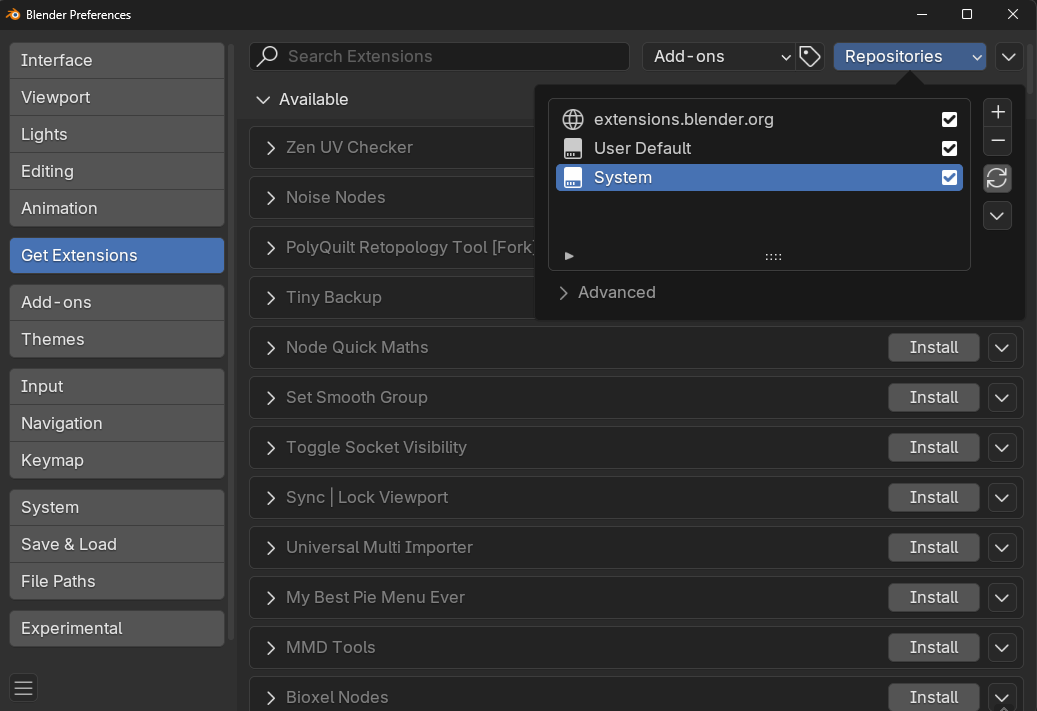
Inside Repositories click the + button and select Add Remote Repository.

Copy https://extensions.polygoniq.com/api/v1/extensions into the URL and click Create.

Check for updates on startup
Toggle Check for Updates on Startup to automatically detect new updates if available.
Custom directory
By default Blender will install the extensions in User Directory. You can install to a custom directory
by enabling the Custom Directory checkbox and selecting a folder.
This will create polygoniq.extensions.com extension repository and you should see a list
of available polygoniq extensions in the extension list. If you have the official blender extensions
repository enabled, our extensions will appear after it (at bottom of the list). You can always
toggle what's visible in the Repositories popover.
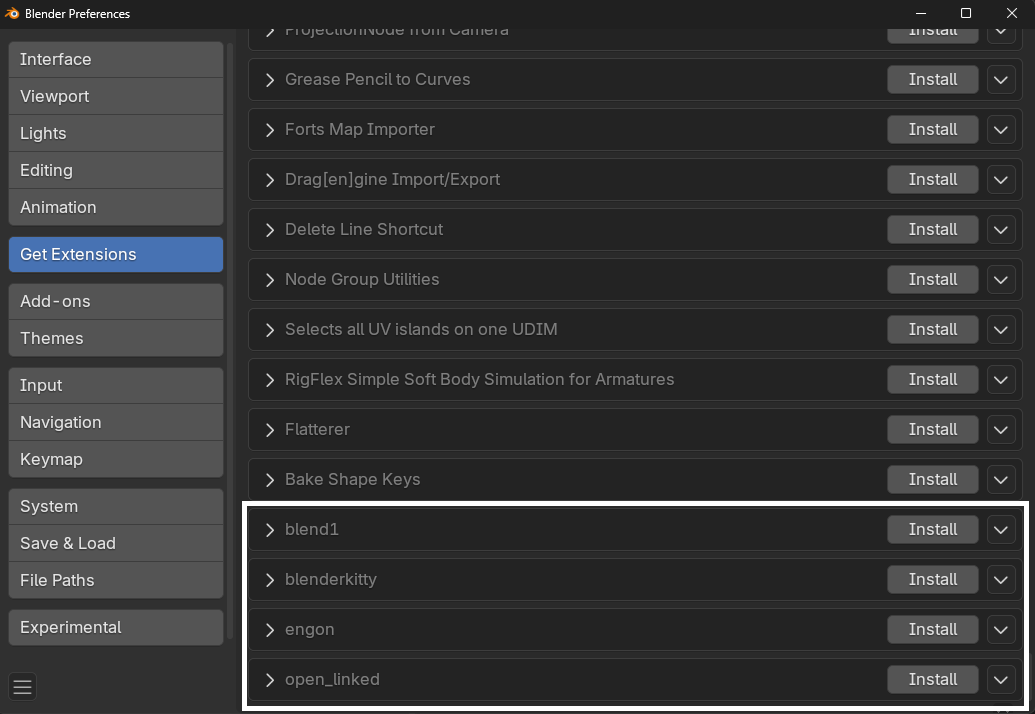
Install From Disk¶
Paid addons (memsaver, renderset, ...) are installable from disk. First, download
the .zip file from BlenderMarket, Gumroad and install it from disk into Blender.
Remote repository
We plan to have all extensions available online, but for now only the open-source versions have a remote repository. Follow our Discord for updates.
This documentation showcases the installation process on engon, but it works the same way
for other extensions.
Remove old addons
Before installing a newer version of addon extension, Uninstall all the previous versions of
the addon in Blender. Having multiple different versions can cause issues and the addon extension
might not work correctly.
Drag & drop the ZIP to install
You can just grab the downloaded .zip file and drop it into Blender to install it.
Once you have the .zip file downloaded, open Blender Preferences and go into the Get Extensions
section. Expand the dropdown in the top right corner and click Install From Disk.
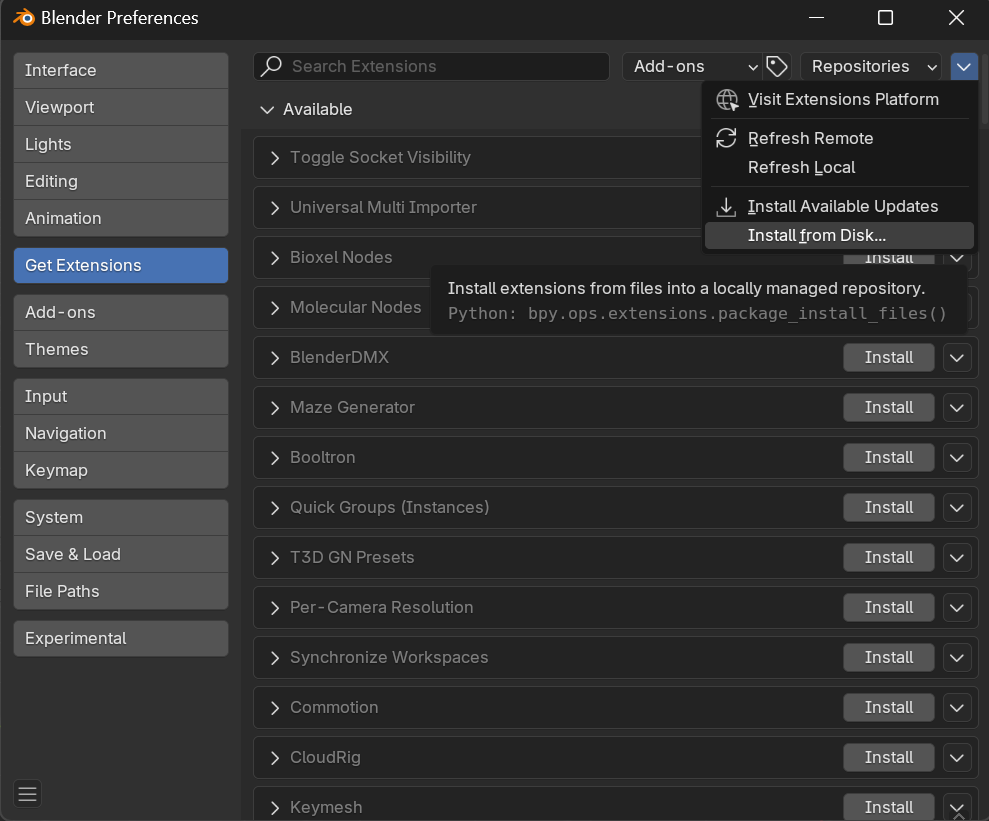
This will open a File Browser. Find the .zip file that you already downloaded, select it and click
Install From Disk.
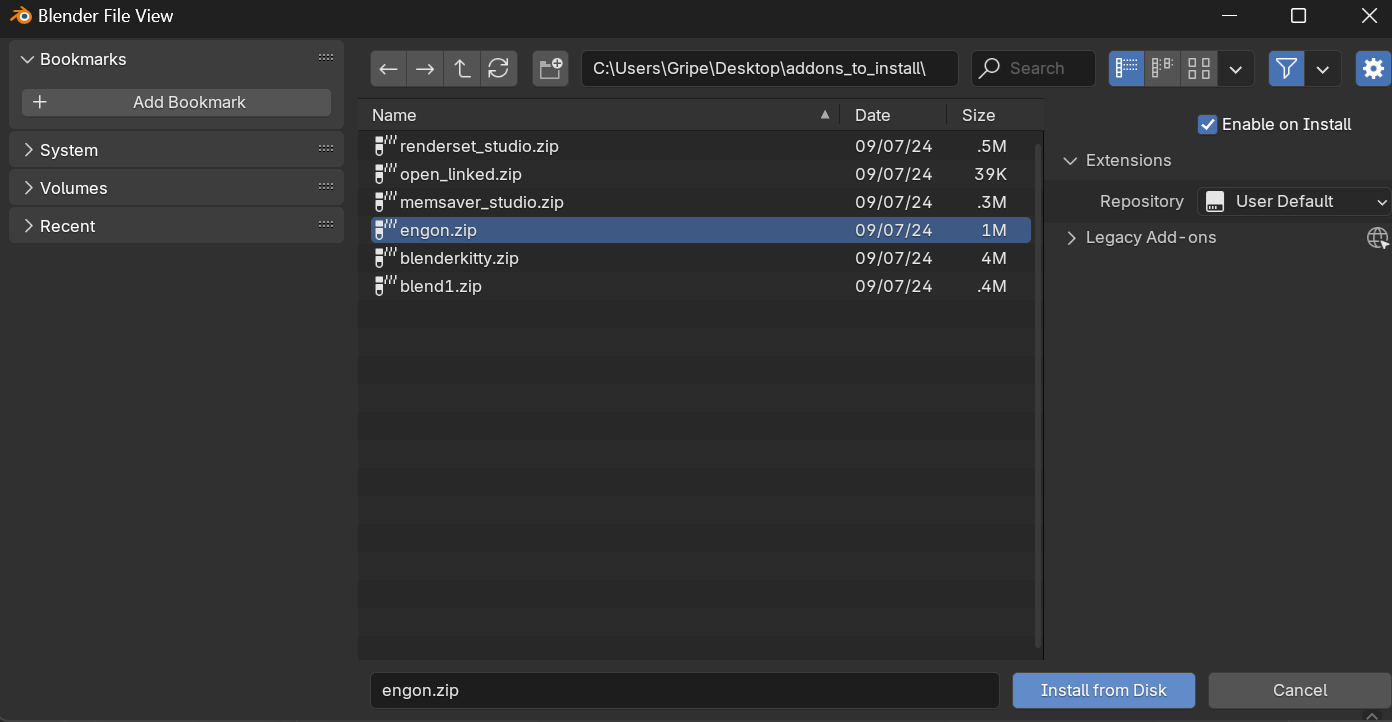
Once the installation is successful, the extension will appear in the extensions list.

You can find the preferences of the installed extension in the Add-ons section.
Type the engon into the search bar to find it quickly.
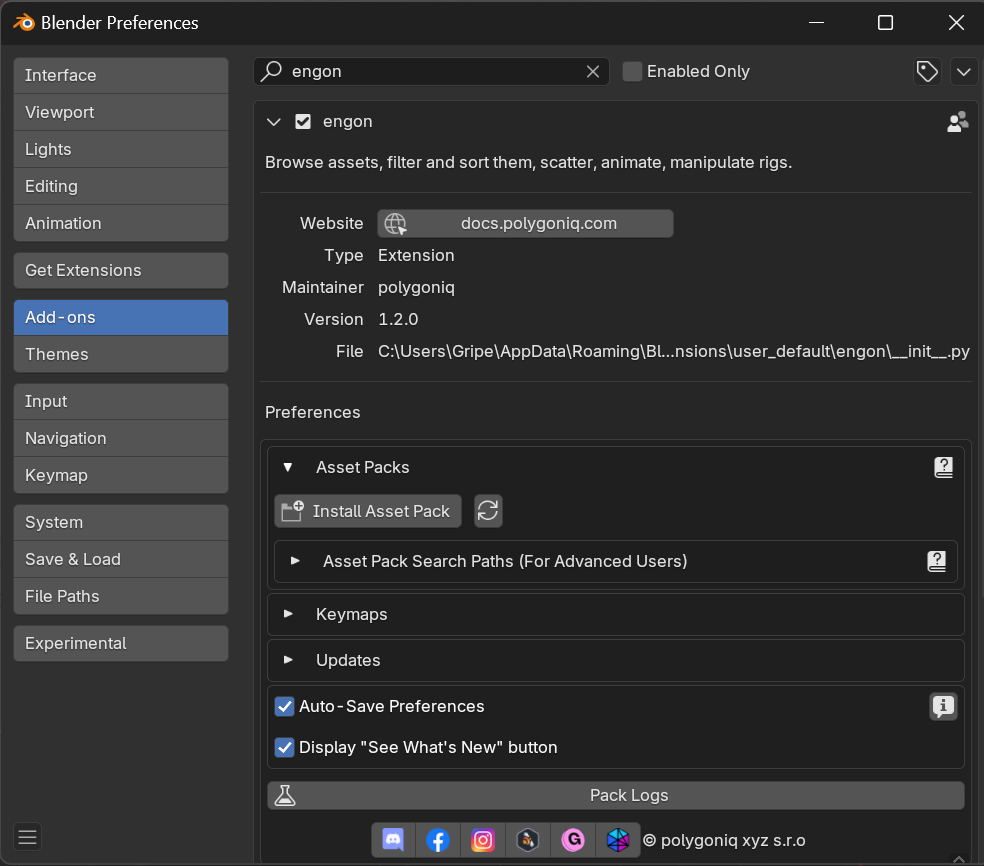
Blender Addon (Blender 4.1 and lower)¶
For one Blender version¶
Engon addon python code is included in a ZIP file. First download the ZIP file from BlenderMarket or Gumroad.
macOS 10 auto extracting ZIPs

Safari might auto extract the ZIP file when downloading. This is undesirable and will prevent the addon from working.
To stop macOS 10 automatically unzipping your files:
- Go into Safari Preferences,
- Locate page titled General,
- Scroll down to the bottom,
- Deselect the box with the text 'Open safe files after downloading',
- engon will now be downloaded as a .zip file and can be installed on macOS 10.
 At this stage you should have an unextracted ZIP file ready on your hard-drive.
At this stage you should have an unextracted ZIP file ready on your hard-drive.
Open the specific Blender version you want to use with engon. Each Blender version
has its own directory for scripts and addons, this directory is not shared between them. In our example
we will use Blender 3.0.1.
One addon installation for multiple blenders
See custom addon path if you want to use engon in multiple Blender versions without duplicating data.
Open Preferences by navigating to Edit → Preferences:
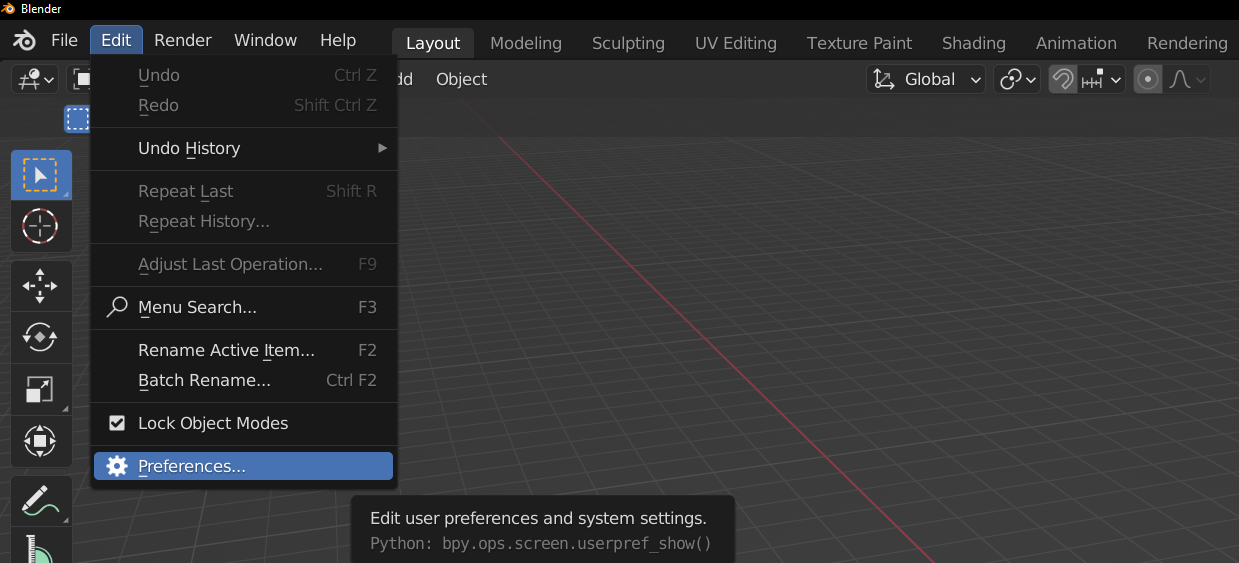
Click Add-ons and then the Install... button:

Navigate to the addon ZIP file you downloaded earlier, select it and click install.

Interrupted installations have to be retried
If you stop the Blender process at this point your engon installation will be corrupted, you will have to remove it and start over.
Not having enough disk space results in a corrupted installation
If you attempt to install engon and do not have enough disk space Blender will still attempt to unpack it and fail. This results in corrupted installations, you will have to free up disk space, remove the corrupted installation and try again.
After a successful installation, check the engon addon to enable it. The addon
preferences should show up and after this point you are ready to use engon
and make some epic scenes!
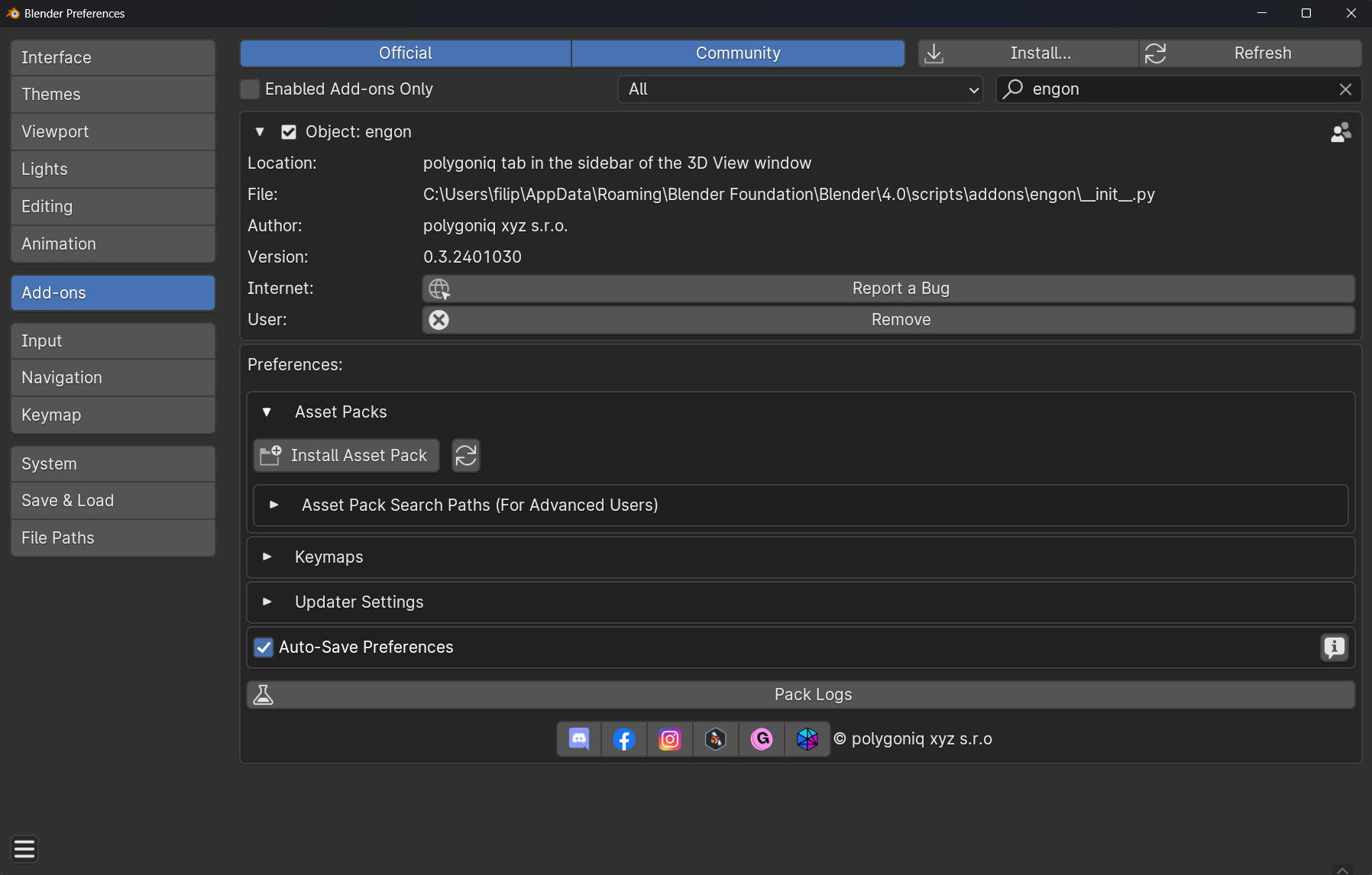
Restart Blender after installing engon
Restarting Blender cleans its Python module cache and prevents issues with old functions being used by accident.
Save Blender preferences
Before you go enjoy engon, click the "hamburger" menu in the bottom left of
Blender preferences and select Save preferences. This will enable engon
on startup. If you omit this step and do not have auto-save preferences enabled,
engon would still be installed after starting Blender but would not
be enabled!

To a Custom Addon Path (advanced)¶
There are cases where you don't want to install the engon ZIP into Blender's default script path:
- you want to use engon in multiple Blender versions
- you want engon on a drive different from the Blender installation
- you want engon in a specific path so that
.blendsshared with colleagues work out of the box
If any of those apply to you, you may want to go the more advanced route and set the addon installation path to a path of your choice.
As a first step, make sure no version of engon is installed. You don't want to run into problems having multiple versions of engon in addon path.
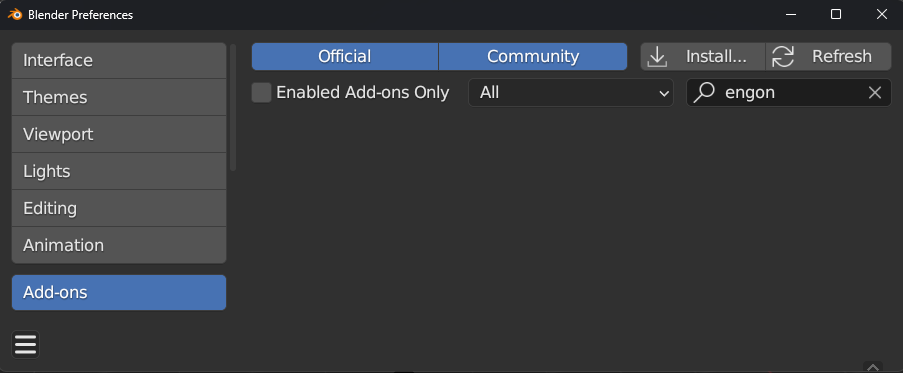
Choose an addon path of your convenience. Make sure this is on a hard-drive with enough free disk space.
In our example we will use C:/blender_addons.
Choose a simple path
We recommend not choosing a path with unicode characters or a path that is too long. Some Operating Systems have path length limits and if you run into those the addon won't be able to find some or all files! Choose something simple, ideally as short a path as possible...
Go to Edit -> Preferences and select File Paths in the left menu. Look for the "Scripts" path
and set it to the C:/blender_addons path.
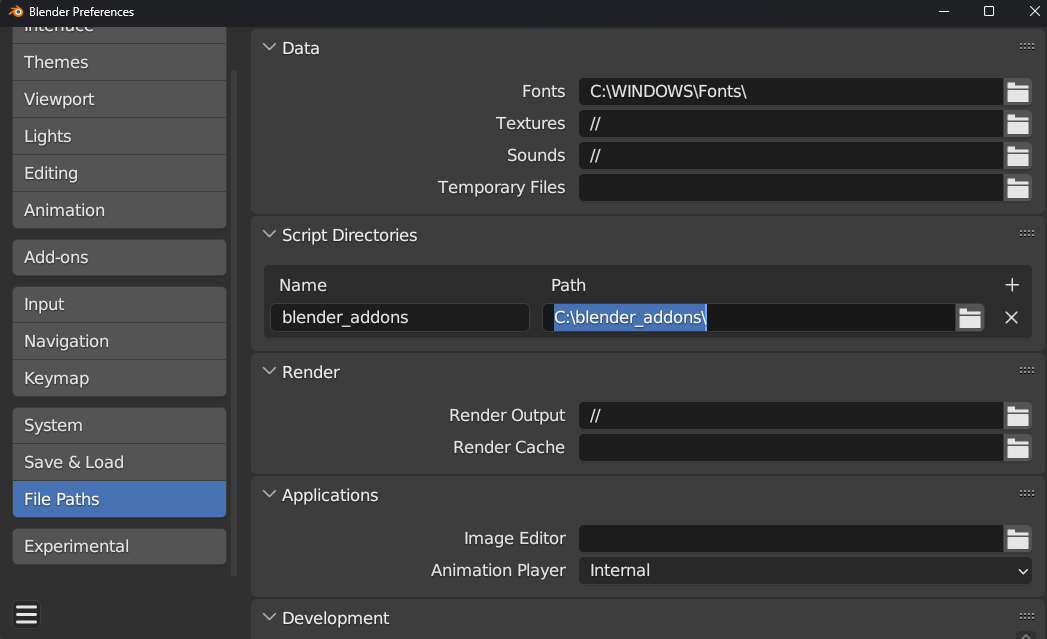
You might need to reinstall addons
If you have addons already installed in the default path you have to reinstall them in the custom path. By changing the script path you are telling Blender to look for user addons elsewhere. The addons included with Blender will still be available but addons you installed yourself need to be reinstalled in the new path.
Now go to the Add-ons tab on the left menu and select the Install... button. Choose the
engon addon ZIP you downloaded earlier. On the Target Path dropdown menu select
Preferences and click Install Add-on. This will unzip the addon into the path selected in "Scripts".

After installation finishes, engon should appear.
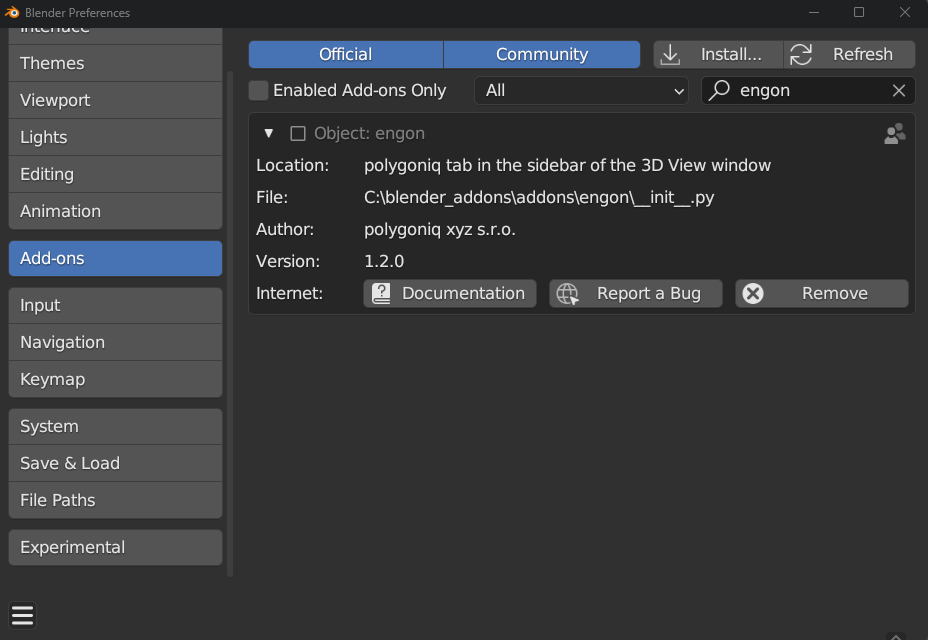
Enable it via the checkbox:
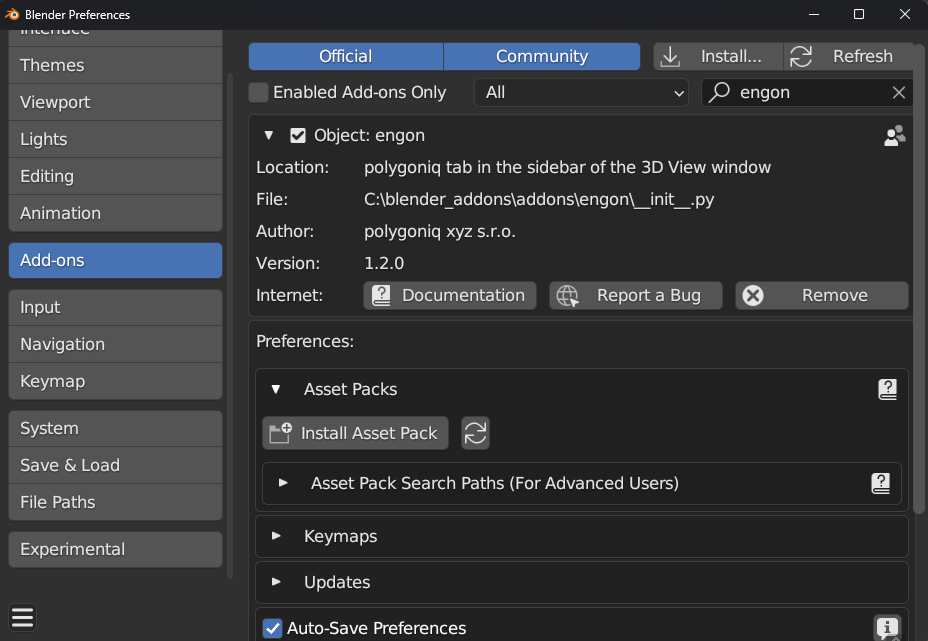
And voila! You have installed engon to a custom path. If you set up the same Scripts
filepath in other Blender versions you may share engon or even other addons across different
Blender versions.
Alternative: Install by extracting the files yourself
Instead of using the Install... button in Blender, you can extract the ZIP to the custom path
using your preferred utility. For example, if we use C:/blender_addons as our desired path, we
create another directory inside it called addons. We set the "Scripts" path as explained above
and extract the ZIP in such a way that the folder inside the ZIP ends up inside C:/blender_addons/addons/.
In our experience extracting with 7zip or a similar tool is faster, especially for large addons.
This procedure may require hitting the Refresh button or restarting Blender for the addon to appear.
Choose the correct path
The folder at the chosen path must contain another folder called addons. Do not set it to
C:/blender_addons/addons, that would not work! It needs to be just C:/blender_addons.
Updating¶
engon contains automatic updating functionality. Updater is located in the engon preferences
under the Updater Settings. You can check for updates by clicking Check now for engon update
or tweak the updater settings. By default the updater checks weekly whether there is a new update,
you can tweak this interval by changing Interval Between Checks.

engon connects to the internet
To figure out the newest version engon connects to the internet and checks against the
public engon repository. If a new update is available it
downloads it from there.
Restart Blender to complete update
After successful update, engon will prompt you to restart Blender to complete the update
process. This cleans the Python module caches and prevents version compatibility issues.
Auto updating can be turned off
If you don't want to use auto updating functionality, you can always download the newest .zip
file from one of the sources and install manually. Don't forget to deselect the
Auto-check for Update in engon preferences.
Addon installation conflicts¶
Having duplicate or outdated polygoniq addons can cause a variety of issues. We suggest to have newest versions when possible.
Symptoms of conflicting addon installations
- Buttons not doing anything
- Panels partially missing
- Preferences interface not being loaded correctly
- User preferences being lost between blender runs
- Question mark icons in engon browser
Why is it an issue?
Addons register code features (buttons, panels, ...) into Blender. Those features have a unique
name in Blender application, if two addons use the same feature (e. g. two versions of engon)
then there will be conflicts.
Additionally we ship shared libraries with our addons. We encapsulated them into each addon in the meantime, but some old versions don't do any encapsulation (make the library available globally), so other addons will use the global library, instead of their own.
Addons will report Conflicting Addons Found in their main panel and in preferences with two
types of messages:
- Old polygoniq addon found, ..., please migrate to
engonandpaqs. - Another installation of addon found (duplicate installation).
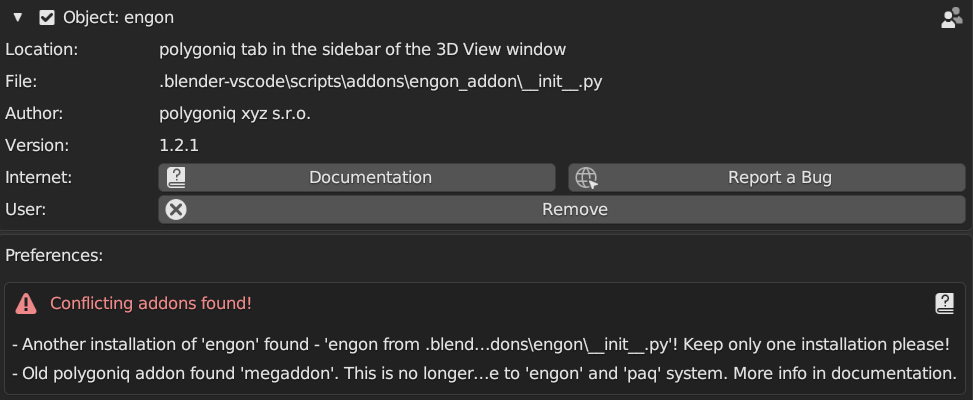

Error is still present even after solving the issue
Error report is updated only once per while. So wait for a ~minute and it will disappear. If not, we suggest to restart Blender.
Old polygoniq addon¶
Ideally you want to use newest versions of our addons, as we test their compatibility and can guarantee it
long term. These old addon installations are no longer compatible if you install newer products like
memsaver, engon, renderset, ..., due to changes in Blender API and so we could move forward and
bring you better centralized user experience.
No longer compatible addons that should be uninstalled and replaced with their new counterparts are:
megaddonaquatiqbotaniqbotaniq_evermotion_am154botaniq_evermotion_am176traffiqmaterialiq
Uninstall old conflicting addons
Error report mentioned in the first section will give you information about what conflicting
addons were found. Go through all of them and uninstall them one by one.
1. Go to Edit -> Preferences and into the Addon section (Extensions if the addon is installed
as extension in Blender 4.2)
2. Navigate to the Search Bar and search for the addons based on error message (or one by
one based on the list).
3. Uninstall the addon
4. After all old conflicting addons were uninstalled Save Preferences and Restart Blender.
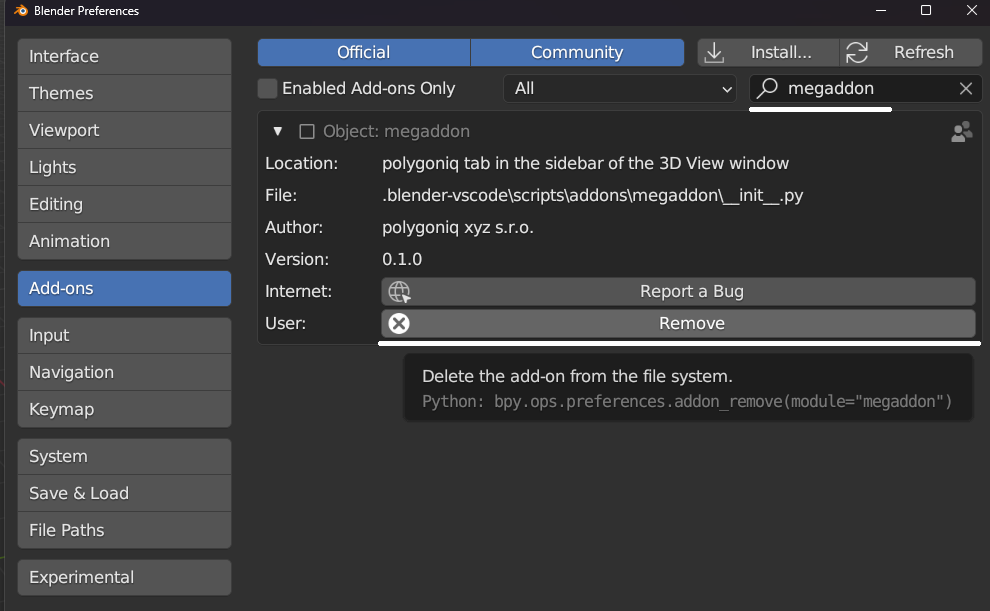
How do I update my asset addon?
Since early 2024 we transitioned old asset pack addons (botaniq including
botaniq_evermotions, aquatiq, materialiq, traffiq) to addon manager engon and .paq asset
packs. You can read more about the engon
and asset packs in the documentation.
The process is now easier, you install only one addon, and manage your polygoniq asset packs inside from one place. Including tools for migrating when asset's are changed and with powerful browser.
I only use memsaver and renderset, do I need to update?
Preferably yes, as fore-mentioned, we guarantee compatibility of the newest versions. There is no need to be afraid, we always keep our addons backward compatible - your data from old versions won't be lost and will work in the newer version.
Duplicate installation of addon¶
Blender allows you to install multiple versions of the same addons. This can create conflicts of the versions overriding themselves. It is suggested to keep only the newest version of the addon.
Keep only the latest version installed
- Go to
Edit -> Preferencesand into theAddonsection (Extensionsif the addon is installed as extension in Blender 4.2) - Navigate to the Search Bar and enter the engon.
- Optionally collapse the preferences to make the view compact and uninstall all versions of the addon except the latest.
- Save Preferences and restart Blender.
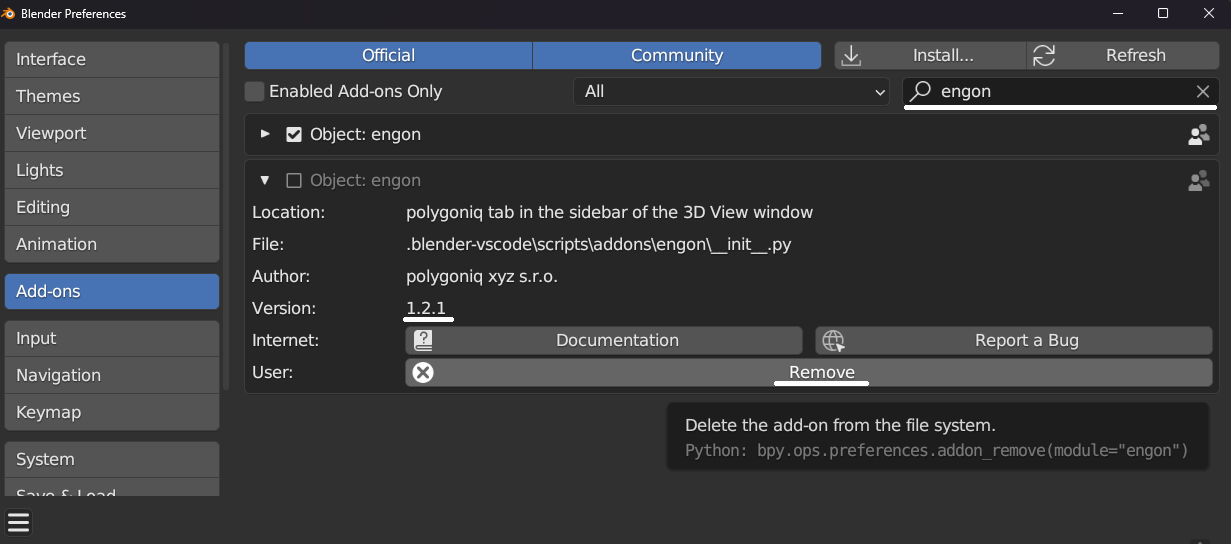
Blender 4.2 repositories
Only one addon extension should be enabled across all repositories at once. Having multiple repositories with different addons is possible, but we recommend using only one addon at once. Otherwise only the addon that's registered the latest into Blender (e. g. based on what addon repository is last in the list) gets its functionality registered.